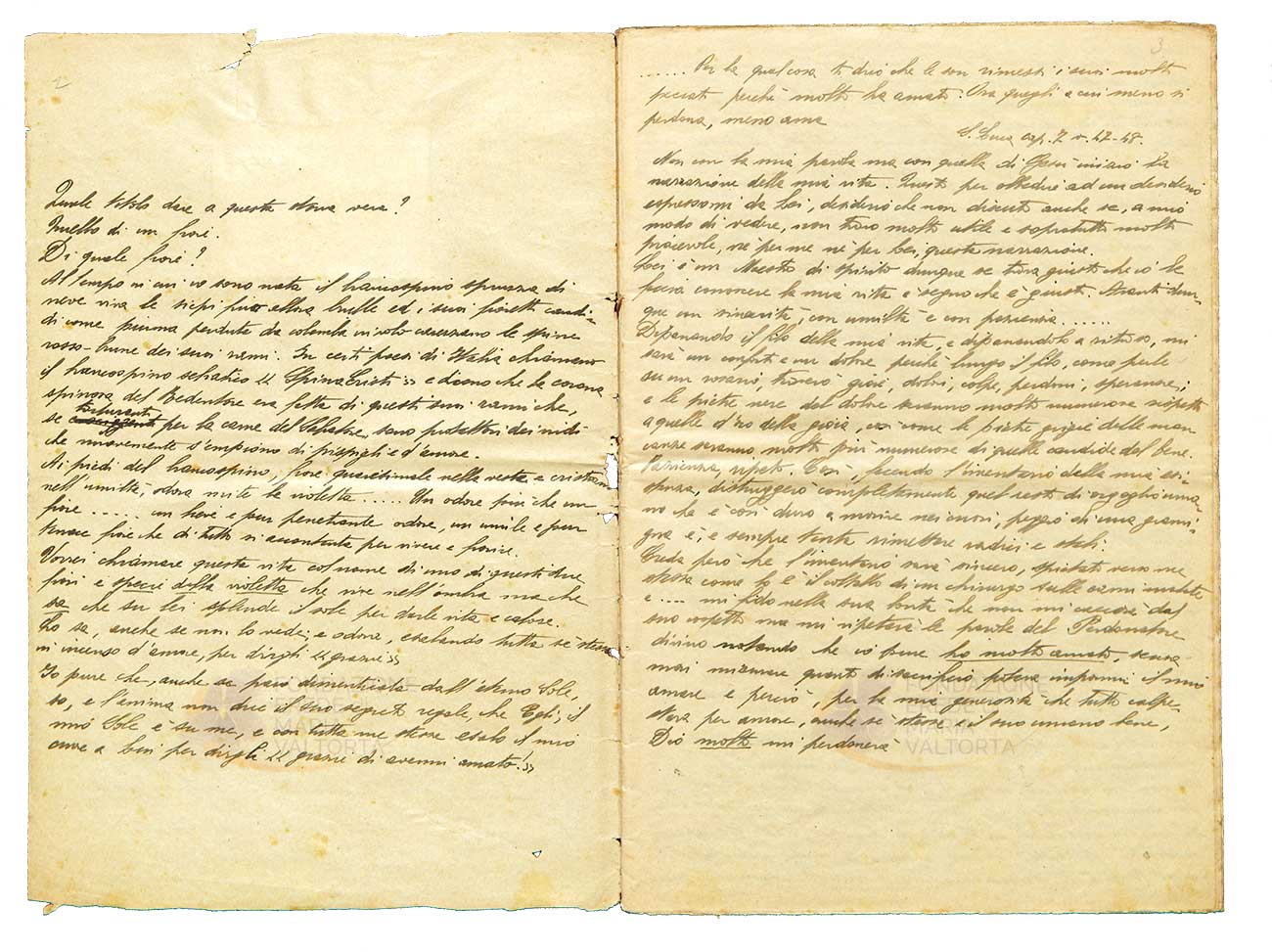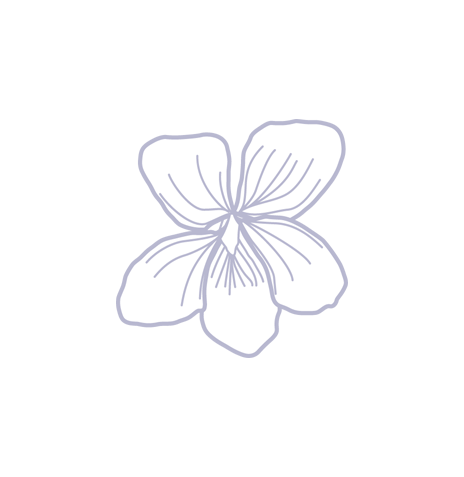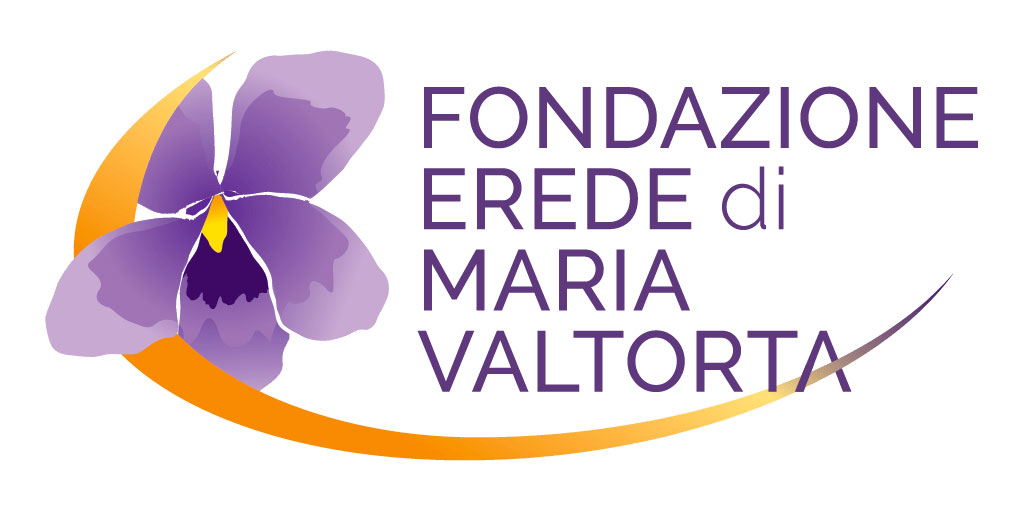Jesus says:
[…] When I inspired the Father to ask you for your little autobiography, I did it because I knew it would be good for you. You expelled, writing it, all the bitterness, all the poison, all the yeast that life had deposited in you. You got rid of it. You needed to repeat to yourself all your suffering and tell it to a Christian heart. It is the thing that most consoles as human being. You needed to do, I will say so, some spiritual accounting to see how much you had given to God and received from God, how much you had given to men and received from men. […]
The Notebooks - 1945, 25 June
MARIA VALTORTA WRITES HER AUTOBIOGRAPHY
Even before being engaged in writing the inspired dictations, in 1943, Maria Valtorta wrote the Autobiography. She did it to reciprocate the desire of hes spiritual director, Father Migliorini, who must have noticed uncommon talents in the invalid Maria.
… “In this account I am present, with my whole self: there is my flesh, with its human passions; my soul, with its spiritual hopes; and my spirit, with its worshiping love.”
MARIA VALTORTA
LENTEN FLOWER
It was already an act of fruitful obedience. Without that complete autobiographical narration, the reader today would have to be satisfied, in order to know the humanity and spirituality of Valtorta, with the hints that appear every now and then in the pages of The Gospel, where our Mary loves to present herself simply as the “instrument”, the “Pen” in the hands of God and like the humble “violet” hidden but fragrant and adoring.
Doveva esserle caro riconoscersi in questo fiorellino che non svetta, ma che in compenso è tutto un profumo di gratitudine al sole che lo scalda e gli dà vita: una silenziosa e scambievole effusione d’amore.
Maria Valtorta chooses this similarity to open the story of her life; but only for a short time will the reader retain the image of her as the “violet” that knows how to perfume, of the “instrument” that knows how to serve.
In fact, we soon realize that Mary did not have the privilege of being born a “flower”, of being preserved from pernicious contacts, and of immediately placing herself in the Sun which warms and nourishes with love. Then it also turns out that Maria was not placed in a completely serene or absolutely pious family environment. Finally, we surrender to the revelation of a woman endowed with a beautiful intelligence, an iron memory, a marked sensitivity, a vast culture and a pleasant appearance: admirable human gifts, but which certainly do not recall the image of the “violet” who only knows how to emanate perfume, or the “tool” that can only be used if guided by an expert hand.
Maria Valtorta was born as one of us, she encounters dangers, cherishes dreams and ideals, suffers pains and misunderstandings, struggles with passions. At a certain point she discovers a wonderful thing:Love. Indeed, from an early age she sensed the existence of this force, of this fire, which immediately presents itself to her as indissolubly united with pain. But if the trusting search alternates with delay or pause, the discovery is finally completed, and with a hymn of joyful and cheering gratitude Maria Valtorta takes the last step. Through the live and active adherence to the pain of the Son of God, who became the Victim out of love, she enters into Love itself which is God.
A spiritual journey that points to God in order to possess Him completely is always fraught with trials. But it appears even more troubled and suffered when – and this is the case of Valtorta – it does not unfold on a terrain of unaware purity and simple faith, but rises from a holocaust of feelings, experiences, prerogatives emptied of all human meanings and filled with the sublime but terrible absoluteness of the Divine. And when Mary has reached this goal she will never go back, as if she no longer belongs to herself, but remains completely fixed in God.
Finally we can now go back to the image of the “violet”, which spreads love by perfuming. And with wonder we discover that this flower, humble and hidden, but nourished by love and itself a lover, represents a “conquest” and not a “privilege”. Wonderful discovery, but above all consoling for our human nature which can – only if we want and if we know how to unite our will to that of God – redeem itself from its depiction of disheartening weight that forces us to the earth, and rises to a shining gem of eternal value.

How often I wished I could place in that pierced hand the fine piece of candy covered with lumps, or the golden one, or the red or pale green one which my grandmother bought for me when taking me to school and which I liked so because they were good and also because they conveyed my grandmother’s love!
...Later, much later, in the pierced hand of Jesus I placed the offering of my life, but, on careful consideration, I feel that—it would have cost me more then to give Him my candy than my life and suffering now...
MARIA VALTORTA
DATI TECNICI
Maria Valtorta wrote almost every day until 1947 and intermittently in the following years until 1951. The notebooks became 122 (in addition to the 7 of the Autobiography) and the handwritten pages about fifteen thousand.
Il manoscritto dell’Autobiografia di Maria Valtorta riempie sette quaderni (il primo dei quali non è proprio un quaderno ma un fascicolo confezionato a mano) per complessive 761 pagine manoscritte. Dopo le prime 42 pagine, Maria inserisce nella narrazione la prima data: Today is March 10 (1943)..
Only at 42 pages to the end of the book, she puts the last date reference: … to the Blessed Virgin Mary whose pains are celebrated today, is the Friday of Passion, April 16, 1943..
From 10 March to 16 April, therefore, Maria Valtorta wrote a substantial central part of the Autobiography, amounting to just under seven tenths of the whole book. Given the due proportions, it can be said that it took her less than two months to write the story of her life. Straight away, without second thoughts or corrections.
LEARN MORE
READ THE AUTOBIOGRAPHY
It’s possible to purchase the book or eBook via the Centro Editoriale Valtortiano

